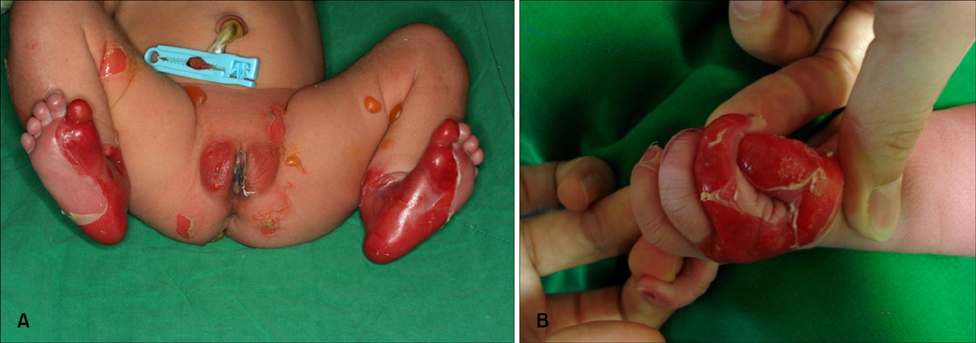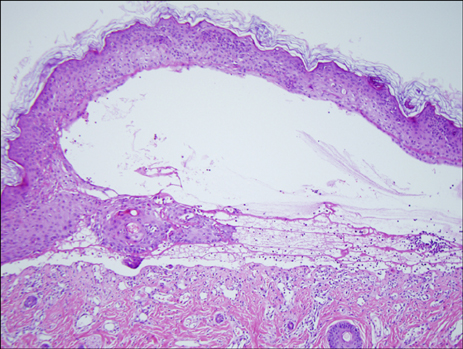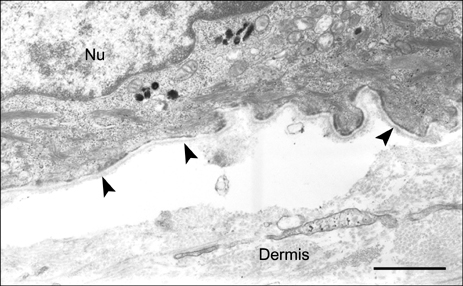Ann Dermatol.
2009 Feb;21(1):49-52. 10.5021/ad.2009.21.1.49.
A Case of Non-Hallopeau-Siemens Recessive Dystrophic Epidermolysis Bullosa
- Affiliations
-
- 1Department of Dermatology, College of Medicine, Dongguk University, Gyeongju, Korea. smg@dongguk.ac.kr
- 2Department of Pediatrics, College of Medicine, Dongguk University, Gyeongju, Korea.
- 3Department of Electron Microscopic Laboratory, College of Medicine, Dongguk University, Gyeongju, Korea.
- KMID: 2172066
- DOI: http://doi.org/10.5021/ad.2009.21.1.49
Abstract
- Dystrophic epidermolysis bullosa (DEB) is a rare group of heritable mechanobullous disorders that are characterized by blistering and scarring of the skin and mucosae and these lesions are induced by minor trauma, DEB is also associated with nail dystrophy. DEB can be inherited either in an autosomal recessive or dominant fashion. Regardless of the mode of inheritance, DEB is caused by defects of the ultrastructural entity known as the anchoring fibril, which results in separation of the sublamina densa. Recessive DEB (RDEB) is classified into Hallopeau-Siemens and non- Hallopeau-Siemens. We herein report on a case of non- Hallopeau-Siemens RDEB and there was no family history of this malady, and we present the clinical, histological and electron microscopy findings.
MeSH Terms
Figure
Reference
-
1. Peter Marinkovich M, Bauer EA. Wolff K, Goldsmith LA, Katz SI, Gilchrest BA, Paller AS, Leffell DJ, editors. Inherited epidermolysis bullosa. Fitzpatrick's dermatology in general medicine. 2008. 7th ed. New York: McGraw-Hill;505–516.2. Fine JD, Eady RA, Bauer EA, Briggaman RA, Bruckner-Tuderman L, Christiano A, et al. Revised classification system for inherited epidermolysis bullosa: Report of the Second International Consensus Meeting on diagnosis and classification of epidermolysis bullosa. J Am Acad Dermatol. 2000. 42:1051–1066.3. Betts CM, Posteraro P, Costa AM, Varotti C, Schubert M, Bruckner-Tuderman L, et al. Pretibial dystrophic epidermolysis bullosa: a recessively inherited COL7A1 splice site mutation affecting procollagen VII processing. Br J Dermatol. 1999. 141:833–839.
Article4. Mckee PH, Calonje E, Ganter SR. Mckee PH, Calonje E, Ganter SR, editors. Epidermolysis bullosa. Pathology of the skin: with clinical correlations. 2005. 3rd ed. Philadelphia: Elsevier Mosby;84–98.5. Jaunzems AE, Woods AE, Staples A. Electron microscopy and morphometry enhances differentiation of epidermolysis bullosa subtypes. With normal values for 24 parameters in skin. Arch Dermatol Res. 1997. 289:631–639.
Article6. Mitsuhashi Y, Hashimoto I. Genetic abnormalities and clinical classification of epidermolysis bullosa. Arch Dermatol Res. 2003. 295:S29–S33.
Article7. Hon KL, Burd A, Choi PC, Luk NM. Epidermolysis bullosa in three Chinese neonates. J Dermatolog Treat. 2007. 18:306–311.
Article8. Rho YJ, Choi YA, Lee KS, Song JY. Epidemiologic study of epidermolysis bullosa in Korea. Korean J Dermatol. 1993. 31:931–936.9. Kim JO, Ryoo YW, Lee KS. Three cases of recessive dystrophic epidermolysis bullosa-mitis. Korean J Dermatol. 2001. 39:1138–1143.10. Yonei N, Ohtani T, Furukawa F. Recessive dystrophic epidermolysis bullosa: case of non-Hallopeau-Siemens variant with premature termination codons in both alleles. J Dermatol. 2006. 33:802–805.
Article11. Abahussein AA, al-Zayir AA, Mostafa WZ, Okoro AN. Recessive dystrophic epidermolysis bullosa treated with phenytoin. Int J Dermatol. 1992. 31:730–732.
Article12. Lee CK, Seo SJ, Hong CK, Ro BI, Song KY, Lee JH. Two cases of dominant dystrophic epidermolysis bullosa. Korean J Dermatol. 1997. 35:758–762.




